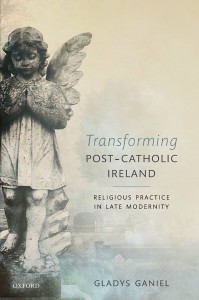 Brian Conway, a lecturer in Sociology at Maynooth University, has reviewed my latest book, Transforming Post-Catholic Ireland: Religious Practice in Late Modernity, in the academic journal Irish Theological Quarterly 81(4), 2016.
Brian Conway, a lecturer in Sociology at Maynooth University, has reviewed my latest book, Transforming Post-Catholic Ireland: Religious Practice in Late Modernity, in the academic journal Irish Theological Quarterly 81(4), 2016.
I’ve reproduced excerpts from the review below. I particularly appreciate how Brian raises questions about how the concept of ‘extra-institutional religion,’ that is described in the book, might be applied more broadly beyond the island of Ireland.
Brian Conway, Review of Transforming Post-Catholic Ireland in ITQ
The religious landscape in Ireland has changed significantly over the course of the last 50 years. Growing religious diversity, the declining influence of the Catholic Church, and the rise of theist/secular/non-religious groups are key elements of this change. For all that, we know relatively little about how ordinary people relate to religion in contemporary Ireland and what this has to say about how religiosity responds to modernity more generally. Gladys Ganiel’s new book—based on survey data, in-depth case studies, and participant observation—sheds light on this important issue and thus represents a key contribution to our understanding of religious change and development. What I found most appealing about this book is the narrative skill, imagination, and keen observation of the author. And so this book will appeal not just to social scientists—sociologists of religion primarily—but to non-specialists and non-academics as well.
… Ganiel’s concept of [extra-institutional religion] EIR—the pivot concept of the book—is interesting for all sorts of reasons.
First, Ganiel shows that even as devotees struggle seek to find greater meaning in their Catholic faith, they do so through the tradition’s repertoire of religious symbols.
Second, EIR shows that institutional religion can operate as an outgroup for adherents, providing an alternative frame of reference against which their own religious identity is defined.
Third, it encourages us not to think of theoretical categories—religion/spirituality, reflexivity/tradition, individual/community—as mutually exclusive.
Ganiel sees EIR as having distinct advantages over traditional religious institutions in that it tends to be more adaptable than slow-moving institutions, even as it remains a part of these same institutions. Applied to the specifically Catholic case, EIR encompasses different units of the church—parishes, lay associations, religious orders—all having quite different relationships to, and levels of autonomy/flexibility vis-à-vis, the mainstream institutional church (defined here as the hierarchy/Vatican). I wanted to know more about this and how this structural position influences (or not) the relative success of these units in affecting the different kinds of outcomes (diversity, ecumenism, reconciliation) Ganiel focuses on:
- How far can EIR go before it is perceived to be ‘breaking the chain’ of the church’s hierarchical authority?
- Under what conditions is it most successful? How does EIR operate for people with low or weak levels of religious commitment (as against the mostly committed adherents studied here)?
- I also wanted to know more about how EIR would operate—or look like—in contexts where the Catholic market share is different, where the church has a minority share and where it has not historically operated as a repository of national identity.
- To put this slightly differently, does the concept of EIR travel well outside of Catholic majority settings like Ireland?
On a substantive level, Gladys encourages to take generational analysis seriously in understanding religious commitment. The Slí Eile and Ballyboden cases, in particular, bring this out. Older adherents in Ballyboden do look quite different from younger devotees in Slí Eile, especially in relation to their view of parishes as sites of Catholic practice. But I still came away from the book wanting to know more about the differences and similarities between pre- and post-Vatican II Catholics, especially in regard to religious socialization, how they relate to church authority, and how religion influences other areas of their lives.
The last chapter of the book steps back from the survey data and case studies to consider the broader implications of the study for religion and society. Here the book takes a more theoretical course, where the author brings a fresh perspective on a long-standing debate about religion in the public sphere, arguing for its continuing positive role. And so the book ends on a practical note by placing before the reader a set of concrete proposals for bringing about inter-religious reconciliation in different national settings. In all, this is a superb book for students of religion.